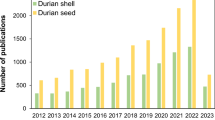Abstract
The carbohydrates content of the water soluble and water insoluble material of the oil and sago palm trunk waste were analysed. The sago palm trunk waste yielded higher water soluble content (17.4%) compared to the parenchymatous tissues and fibers of the oil palm trunk waste i.e. 3.3% and 5.4%, respectively, with less than 10% of neutral carbohydrates detected by cysteine sulphuric assay. However, hot water solubles of the sago palm trunk contained about 61.7% glucose. On the other hand, the acid hydrolysable carbohydrates of the water insoluble materials of both oil and sago palm trunk waste were found to be less than 50% of the total materials. The fibers and parenchyma of the oil palm trunk yielded only 31.9% and 23.6% hydrolysable sugars, respectively. Glucose was the major monosaccharide afforded by all samples of oil and sago palm waste.
Similar content being viewed by others

Author information
Authors and Affiliations
Additional information
Received 26 November 1998
Rights and permissions
About this article
Cite this article
Akmar, P., Kennedy, J. The Potential of Oil and Sago Palm Trunk Wastes as Carbohydrate Resources. Wood Science and Technology 35, 467–473 (2001). https://doi.org/10.1007/s002260100107
Issue Date:
DOI: https://doi.org/10.1007/s002260100107



